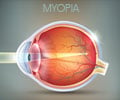Combination approach using eye drops and contact lenses to slowing nearsightedness (myopia) in children was found to show promise, stated new study.

‘In children with higher myopia, combination treatment was 28 percent more effective compared with contact lenses alone. In children with lower myopia, combination treatment was 38 percent more effective.’





Nearsightedness may not seem like a serious eye condition. Glasses and contact lenses can provide effective treatment. But high myopia, defined as -6 D or more, can lead to potentially blinding complications, such as glaucoma, retinal detachment and retinal degeneration.Myopia can’t be stopped, but it can be slowed. There are two methods for slowing progression. One method uses 0.01% atropine eye drops, instilled in the eye every day. Atropine is a medication commonly used to dilate or widen the eye before an exam. How it slows progression is unclear (some evidence suggests atropine blocks muscarinic receptors in the retina). But research shows it is effective and safe.
Another method is orthokeratology, which involves using rigid gas permeable contact lenses every night to reshape the cornea, the clear, front part of the eye. It’s also unclear how contact lenses slow progression, but it is thought that reshaping the cornea changes the peripheral focus of the eye to reduce myopia progression. There are risks with overnight contact lens wear, such as corneal abrasions, ulcers or infections, and scarring that can lead to vision loss. Myopia progression can rebound with both methods, though less so with 0.01% atropine.
Two treatments, each effective, each appear to work in a different way. What if they were combined? Would the combination have an additive or synergistic effect?
To learn more, Nozomi Kinoshita, M.D., Ph.D., and colleagues at Jichi Medical University in Japan, randomized 80 children into two groups: one received both orthokeratology and atropine, while the second group received only orthokeratology. The children, aged 8 to 12 years old, exhibited a range of myopia, from low to high (from -1D to -6 D). They were treated for three months and then followed for two years.
Advertisement
Source-Newswise











